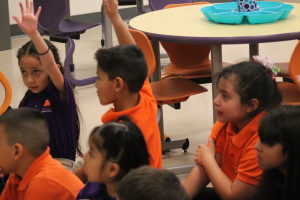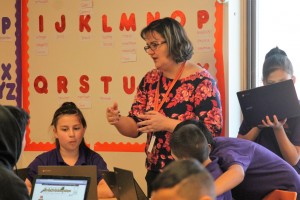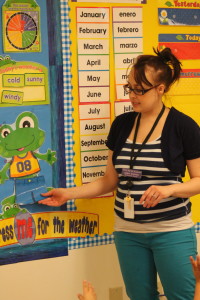
As they stood in line waiting to go into the classroom after lunch, Jackson wondered aloud, “How do you pronounce that in Spanish,” the 6-year-old said to classmate Alexa, as he pointed up at an ‘EXIT’ sign.
“Salida,” she quickly responded.
It is something that happens frequently throughout the day at Salida del Sol Academy in Greeley.
The bilingual charter school on the east side of this northern Colorado community opened in the fall of 2014 specifically so students who only speak Spanish can get an education in their native tongue while learning the language of their new home. At the same time, English-dominant speakers learn a second language, and dual language students work to improve both.
The school is one of five charter schools in Greeley-Evans School District 6 that offer a unique spin on education for more than 25 percent of the 21,500 students in Colorado’s 13th largest school district.
Jan. 28th, more than 600 students, parents, teachers, state legislators, and others gathered at the Colorado Capitol to show support for school choice of all kinds. Charter schools were heavily represented at the rally, which comes as no surprise. There are now more than 220 charter schools in Colorado, with more than 103,000 students—about 12 percent of total public school enrollment in the state. If these schools constituted their own school district, it would be the largest in Colorado.
And the charter sector isn’t done growing, an average of 10-15 new charter schools open yearly in Colorado.
HISTORICALLY, LOGISTICALLY, AND ACADEMICALLY, COLORADO LEADS THE WAY
In 1993, Colorado became the third state in the United States to pass a law allowing for the creation charter schools. The first two schools opened that fall, the Connect School in Pueblo and Academy Charter School in Castle Rock. They are both still open today.
The road hasn’t always been an easy one, said Nora Flood, president of Colorado League of Charter Schools (CLCS). Over the past 23 years, 35 charter schools statewide have closed—some for financial reasons, some for academic reasons. Things are looking up, however.
“We are no longer a movement; 15-20 years ago, we were a movement,” Flood said. “We are an anchored sector of K-12, but we have to maintain the zeal of a movement.”
CLCS is a nonprofit, membership-based organization that supports Colorado’s charter schools, helping them reach their goals of high student performance and success. It provides information and resources in technology, advocacy, public relations, and other areas.
Flood said Colorado’s charter schools lead the way in a wide range of areas.
- Minority students make up 45.9 percent of students in charter schools compared to 45.5 percent in traditional schools.
- In 2013-14, the most recent year for which information is available, 71 percent of Colorado’s charter schools are classified Performance under the state’s rating system, compared to 67.2 percent of traditional schools.
- On average in 2013-14, charter school students outperformed traditional school students in every subject and every demographic group on standardized tests.
- Six of the 10 Colorado high schools with the top ACT scores were charters.
- For four years in a row, Liberty Common High School in Fort Collins received the highest composite ACT score in the state with a 27.07 out of a possible 36.
- Six of top 10 overall high schools in Colorado according to US News and World Report were charters.
- Colorado’s charter law is among the strongest nationwide, ranked fifth according to the National Alliance for Public Charter Schools – Measuring Up to the Model: A ranking of State Charter School Laws, seventh edition, January 2016.
Flood said Colorado’s charter schools’ success have changed the way people see education.
“We spend more time picking out a car than we do a school for our kids,” said Flood, who was a teacher for three decades before joining CLCS eight years ago. “You should shop for a school. You should go into a school and visit. If you choose a traditional district ran school, hallelujah. But you should find a school that fits your student. I challenge parents to ask traditional building administrators what their mission and model is. Very often they lack the autonomy to think it through. ”
FACTS, FACETS, AND FALSEHOODS

“If you have to go someplace you don’t want to go—kinda like the grocery store, if you have to go to the grocery store with your mom and you don’t want to—you’re not going to pay attention to anything,” said Janaya Chilcott, a sixth-grader at Salida del Sol. “If you have to go to a school because you live by it, but you don’t like it, you’re not going to be as focused.”
Chilcott was talking about why being able to choose where you go to school is important.
Charter schools were designed to offer parents a choice in how their children are educated. Janaya is a 12-year-old girl who lives with her father and grandparents on the west side of Greeley in a mostly middle- to upper-class, white neighborhood. She attended a predominantly white and higher socio-economic school traditional school just few blocks from her home through the fourth grade.
However, when the family learned about Salida del Sol’s mission, Janaya knew she needed to make the change.
“We let her decide 100 percent,” said Janaya’s grandfather, Ed Chilcott, a Greeley pastor who has helped raise his granddaughter for most of her life. He has cared for Janaya on a full-time basis since her mother died nearly three years ago. “We wanted her to go, of course, but we were not going to force her to do anything she didn’t want to.”
Chilcott liked the idea of Salida del Sol because it was the exact opposite of what his granddaughter was getting at the time. And having built churches in Puerto Rico and Costa Rico, the advantage of Janaya learning Spanish was something he valued—despite the fact that the school was several miles from his home, there was no busing, and it was located in a heavily hispanic area with much lower socio-economic families.
“These were all non-issues for us,” Chilcott said. “We wanted her to experience the real world. It is so much different than when we were growing up. And diversity in our children is a benefit to them.”
Now, for the second year Chilcott and Janaya’s father take turns driving her to school each morning and picking her up each afternoon.
The lack of busing keeps many from taking advantage of charter schools, Flood said.
“Unless a district sees charters school students as their students too, and they provide transportation for families to access that charter school, then by default the only parents who can get their children there are the parents who can drive,” Flood said. “That eliminates a contingency of parents who might want that chance.”
Flood praised Denver Public Schools for making their charter schools a part of their overall choices for families in the district. During open enrollment, DPS families have to rank the schools they’d like their children to attend. DPS also created Success Express, Flood said, which transports students from a specific geographic area of the district populated by mostly at-risk students to the school of their choice.
There are many falsehoods that Flood fights daily, adding there are some very specific aspects of charter schools that she tries to drive home to parents every day.
- Charter schools are PUBLIC schools. They are tuition free and governed by state and federal laws that traditional schools do. Charter schools offer free and reduced lunches, reduced and free fees on extracurricular offerings such as sports, and help with other fees and costs associated with all schools.
- They do not discriminate.
- Are forbidden from teaching religion.
- All students are eligible to attend charter schools.
- There is no advanced test-in requirements.
- Must take all the same state assessment tests.
It’s been 23 years, Flood said, and getting people to understand that all charter schools are public schools is still the greatest challenge.
In fact, Flood shies away from the national charter school label of “public charter schools,” instead calling them “charter public schools.”
“Calling them public charter schools still leaves some implication that there are private charter schools, and there are not,” Flood said. “Charter schools are public. Charter school parents are tax-paying parents. Charter school students are public school students that deserve every right traditional school students get.”
Charters also face uphill battles for equal funding. Although they receive the same per pupil funding that traditional schools receive, the district they are approved to operate in retain some of that money (up to 5 percent) to pay for administrative costs.
In many cases charters don’t receive local money from bond and mill levy override revenue, which leads to charters spending on average more than $600 of per-pupil funding on facilities—a situation that often leads to lower teacher salaries.
Finally, charters face negative scrutiny from the status quo, Flood said. Charters break the “zip code school” model. It’s very political at times.
“They see us as unhealthy competition in a landscape of scarce resources,” Flood said. “We also have not had any traction with unions. So they see us as union busters. We try to keep it as close to the kids as we can. And we hold dear the idea that we can hire and evaluate and keep or not keep the very best teachers that fit our missions and models. And that is a threat to the establishment.”
SATISFIED SOLUTIONS

Yet, charters continue to flourish despite all the challenges. The only difference between charters and traditional district opperated schools is autonomy over myriad aspects, such as hiring and curriculum.
Charter schools can be innovative and entrepreneurial, with rigorous curriculum. All charter schools are different, with different missions and education delivery methods so parents can select schools that best fit their child.
In Greeley, for instance, the five charter schools offer Greeley’s families everything from Core Knowledge to student-directed learning to college preparatory work to constructivism and the bilingual offerings at Salida del Sol.
Charter schools have always had bipartisan support. Colorado Gov. John Hickenlooper is quoted by CLCS as saying Charter schools have dramatically expanded choices for parents.
“We’re giving our citizens more choice than they could ever have imagined 20 years ago” Hickenlooper said.
Despite the lack of transportation, lower salaries, and less money to spend in the classrooms, teachers and students continue to flock to charter schools for educational needs.
Fifteen new schools opened this year alone, with another long list set to open in the fall of 2017.
Most importantly, all involved said, is the level of attention and innovation students get.
“I really like how my teachers are not like regular teachers,” Janaya said. “They really have time to help you.… . There is more facetime, and they expect more out of you. There are more challenges and higher expectations.”
Note: This is the first in a series of periodic reports about charter schools and other innovative teaching methods used across Colorado and the nation.


